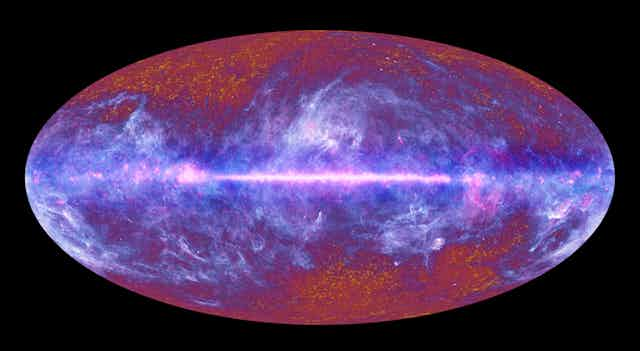Interest in the multiverse theory, suggesting that our universe is just one of many, spiked following the release of the movie Everything Everywhere All At Once. The film follows Evelyn Wang on her journey to connect with versions of herself in parallel universes to ultimately stop the destruction of the multiverse.
The multiverse idea has long been an inspiration for science fiction writers. But does it have any basis in science? And if so, is it a concept we could ever test experimentally?
That’s the topic of the third episode of our podcast Great Mysteries of Physics – hosted by me, Miriam Frankel, science editor at The Conversation, and supported by FQxI, the Foundational Questions Institute.
“One way to think of a multiverse is just to say: ‘Well, the universe might be really, really big – much bigger than our observable universe – and so there could be other regions of the universe that are far beyond our horizon that have different things happening in them’,” explains Katie Mack, Hawking chair in cosmology and science communication at the Perimeter Institute for Theoretical Physics in Canada. “And I think that idea is totally well accepted in cosmology.”
The idea that there could be other parts of the cosmos with different physical laws, processes and histories is hard to ignore. And the concept is consistent with the theories of quantum mechanics, which governs the micro-world of atoms and particles, string theory (an attempt at a theory of everything) – and also with cosmic inflation, which says the infant universe blew up hugely in size during a brief growth spurt, and then continued to grow at a less frantic pace. These theories each give rise to their own version of the multiverse theory.
For Andrew Pontzen, a professor of cosmology at University College London in the UK, quantum mechanics is the best reason to believe in the multiverse. According to quantum mechanics, particles can be in a mix of different possible states, such as locations, which is known as a “superposition”. But when we measure them, the superposition breaks and each particle randomly “picks” one state.
So what happens to the other possible outcomes? “There’s a brilliant way of understanding this which is to imagine that, actually, the reality we experience is just one kind of facet of a much more complicated multiverse, where pretty much anything that can happen does happen and we just experience one version of events,” explains Pontzen. “Although it sounds crazy, it’s sort of the least crazy option for understanding how quantum mechanics can be right.”
Not all physicists are fans of the multiverse, though. Many argue that if it’s impossible to ever observe other universes, the multiverse can’t be a scientific theory. “I think it’s fine for entertainment,” says Sabine Hossenfelder, a research fellow at the Frankfurt Institute of Advanced Studies, who describes the multiverse as “ascientific”. “You sometimes hear people talk about some kind of mathematical evidence. [But] that’s just not a thing – evidence is something that you actually observe.”
There is currently no observational support for the multiverse theory. However, Mack doesn’t think that necessarily means it is unscientific. “I don’t think that hypothesising the existence of something unobservable is inherently unscientific,” she argues. “The wave function [in quantum mechanics] is unobservable. We have ways to infer the existence of the wave function because the maths all works perfectly. That we never directly observe it is a little beside the point, because it’s such a basic part of the science.”
Pontzen, though, is optimistic that we may one day be able to see signs of a collision with another universe in the cosmic microwave background, which is the light left over from the Big Bang. He is also working on a laboratory experiment trying to shed light on how a baby universe could actually physically be born from a multiverse.
You can listen to Great Mysteries of Physics via any of the apps listed above, our RSS feed, or find out how else to listen here. You can also read a transcript of the episode here.


